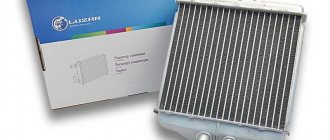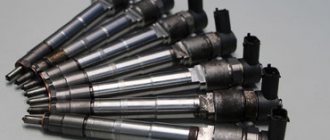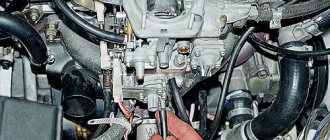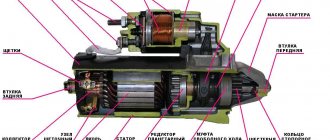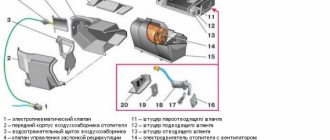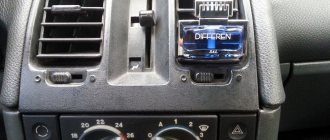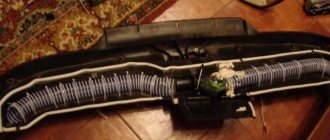Daewoo Nexia › Logbook › Replacing the heater radiator
Since purchasing the car, I noticed that the antifreeze was slowly leaving.
Every few months I had to add 200 grams or even less. There were no visible leaks anywhere, the timing belt was changed last summer, when it was replaced the pump was inspected, everything was dry. The carpets in the cabin were always dry. The worst thoughts about a broken cylinder head gasket were not confirmed; no signs were found. In the end, I gave up on this matter and just added a little antifreeze; a canister with residue left over from last summer when I changed the antifreeze. Once again I topped it up to the maximum, but a week later for some reason I decided to check the level again, something tugged at me and for good reason! The level was at a minimum, which shocked me to put it mildly. Those. Over the course of a week, about a liter of liquid leaked (that much later had to be topped up to the maximum). I checked everything under the hood again, no leaks. Blown head gasket - no. All that was left was the stove, so I went into the cabin to sort everything out, even though it was still dry there! In the end, it turned out to be her problem. What happened next was more interesting. Over the next few days, when driving to work and back, a distinct smell of antifreeze began to appear in the cabin, and steam was coming from the air deflectors. =))) In the stores I visited there were aluminum and copper analogues, aluminum was immediately swept away, and copper analogues ( which were available in stores) judging by the reviews on the Internet, they begin to flow after six months or a year, their quality is not ice. It was not possible to find a high-quality analogue, so I had to take the original from the Uzbeks for 3,000 wooden ones. It’s expensive, of course, but I’m making the car for myself and I won’t sell it until I save up for a new one. =) So I took the original so that in a year I wouldn’t have to change it again.
Unfortunately, I didn’t have a camera at hand, because I didn’t count on this activity. All I have are a few poor quality phone photos. In short, the replacement process comes down to disassembling the center console, in general, in my opinion, there is nothing complicated there, everything that is there is removed one by one, only there are a lot of screws. In 40 minutes the entire center console was scattered.
Next, the antifreeze is drained and the hoses are removed from the radiator. The easiest way to get to the clamps is in a hole or on a lift. We free ourselves from the radiator mounts in the cabin and that’s it, the radiator can be removed. Reassemble in reverse order. It would be advisable to dry all the rugs and everything under them before doing this. I covered the radiator casing with isolon so that the radiator heats up the plastic less and so that at least some of the heat is reflected and goes back, i.e. to the salon.
By the way, when we first accessed the radiator, there were a lot of leaves and other debris in the casing. This is what it means that there is no cabin filter. But in winter, this garbage worsens the heating of the cabin.
Source
Replacing the heater radiator Daewoo Nexia 150 body
Today we’ll talk about how to remove the heater radiator from the Nexia. Daewoo Nexia quickly gained a wide circle of admirers, thanks to its simple and inexpensive maintenance. But we will talk about the heating system or stove, as car enthusiasts call it.
It is simple and understandable so much that even a novice car owner can easily troubleshoot problems that rarely, but still appear. And then, in cold weather, the car cannot warm up. It becomes unbearably cold in the cabin.
Problems with the stove can arise for a number of reasons. For example, if you saved on cheap antifreeze - coolant. Or the radiator was not properly maintained. Correct installation of the heating device also plays an important role. However, you shouldn’t be upset right away. We will help you understand on your own how to replace the stove radiator with a Nexia.
One of the first reasons for a non-functioning radiator may be a leak. There may be poor quality spare parts, or the radiator was installed incorrectly, or negligent maintenance of the stove. The fact that a leak has formed can be seen in the puddle that spreads under the car. If you see spilled antifreeze, this means only one thing - the radiator is cracked.
How to replace the heater radiator on a Daewoo Nexia
First of all, you need to prepare the entire collection of screwdrivers, with a ratchet including a 7mm socket, pliers with thin lips and a jack.
The latter is needed if you are not the happy owner of an inspection hole in the garage. Buy the heat exchanger itself. They are almost the same on many Nexia models. The difference is small in the connections, but they are quite interchangeable. Using the example of the Nexia N100 and N150 models, you can see the difference in the size of the heater radiator. N100 - 182x141x51; N150 - 180138.526. Now you can drive the car to the inspection hole or lift it on a jack. Then you need to drain all the antifreeze into some container. We will still need it. It would be nice if you flush the entire system at the same time. When thinking about how to remove the heater radiator on a Daewoo Nexia, you must ensure electrical safety. Therefore, you should disconnect the clamps from the battery. In order to remove the heater radiator on a Daewoo Nexia, it is not necessary to disassemble the entire car. It is located quite easily to access. Next to the center console, which separates the driver and front passenger seats. Under the dash on the passenger side.
How to get to the heater radiator on Nexia?
So, let's begin. 8 recommendations to help you understand how easy it is to change a stove radiator on a Nexia.
How to change the heater radiator on a Daewoo Nexia?
Of course, the work is not easy. However, it is worth considering that such a service costs about 3 thousand. However, if you have any difficulties with the work, we recommend that you contact a professional car service center. We wish you successful completion of this work. We will be glad if our article helped you. Good luck on the roads!
Source
Replacing a radiator heater on a Daewoo Nexia - photos and videos
There is probably nothing more unpleasant than driving a long distance in a cold car in winter. Any malfunction of the heater radiator in the Daewoo Nexia makes it impossible to operate the car in the cold season. Therefore, in the fall, all car owners usually carefully check the condition of their heating system and, if necessary, immediately replace the furnace equipment.
Main stove malfunctions
Failure of the stove can lead to unpleasant consequences for the driver. This is felt most strongly in the cold season. When such a situation occurs, it is first necessary to accurately diagnose the cause of the malfunction.
The stove heats the air poorly
Play may appear on the damper drive. In this case, the stove will operate normally, but due to the play, the damper will begin to bend under its own weight, forming a gap. Through this gap, cold air will begin to flow into the cabin, reducing the temperature in the cabin.
If the stove heats the air poorly, you need to adjust the dampers
This malfunction is due to the design features of the stove structure and the location of the damper. The damper is installed directly in front of the heater radiator and must always be in a raised position for free passage of cold air to the radiator. If the cable drive is weakened, it changes its initial position, and cold air begins to flow not to the radiator, but into the passenger compartment.
It is quite easy to fix this problem: you will need to seal the gap formed in the damper so that cold air flows do not enter the cabin through the stove. More detailed instructions will be provided below.
The heater works, but does not direct air flow to the legs
Sometimes the stove starts working strangely. It heats the air normally, but does not allow air flow to be directed to the lower part of the cabin. The problem, again, lies in the damper, the drive of which does not allow the lever to open the “feet” position. In this case, you will have to remove the central panel of the machine and adjust the cable mechanism.
Reasons for replacing a stove radiator with a stove radiator
And yet, the first reason why you have to replace it is a radiator leak.
Not the best quality of parts supplied to the conveyor (depending on the manufacturer), incorrect operation, and incorrect installation also play a role here. A heater radiator leak is immediately noticeable, since it always leaves traces of antifreeze in the cabin. There is no point in delaying replacement, as the crack will not heal on its own, but will only get bigger. Unfortunately, most modern stove radiators are made of aluminum and are practically irreparable.
Where is the radiator on the Daewoo Nexia?
As in most cars, in the Daewoo Nexia the heater radiator is installed under the front panel in the glove compartment area, closer to the center console.
But unlike many models, to replace the radiator you do not need to disassemble half of the interior and remove the panel. The work is not particularly pleasant and long, but there is nowhere to go. At the service, only for a replacement they ask from 2500 to 3000 rubles and two to three hours of time. Perhaps replacing the stove radiator on a Daewoo Nexia with your own hands will take more time, but saving three thousand will be pleasant compensation for our torment.
Daewoo Nexia 2005, 85 l. With. — self-repair
The element body can be pulled out. Reasons for replacing a stove radiator on a stove radiator And yet, the first reason why you have to replace it is a radiator leak.
A heater radiator leak is immediately noticeable, since it always leaves traces of antifreeze in the cabin. There is no point in delaying replacement, as the crack will not heal on its own, but will only get bigger.
Unfortunately, most modern stove radiators are made of aluminum and are practically irreparable. Where is the radiator on the Daewoo Nexia? As in most cars, in the Daewoo Nexia the heater radiator is installed under the front panel in the glove compartment area, closer to the center console.
The edge of the radiator can be seen behind the driver's pedals. And these are underwater tubes hidden under the carpet.
You need to have great knowledge of the sequence of actions. And we, so be it, will share it. Is it difficult to remove the radiator of the Nexia stove?
We collect pockets full of screwdrivers and a ratchet with a 7-mm head. You can grab a bottle of water so as not to be distracted from work. Otherwise, we like to procrastinate, just not to work: All we have are a few photos on our phone of poor quality. In short, the replacement process comes down to disassembling the center console, in general, in my opinion, there is nothing complicated there, everything that is there is removed one by one, only there are a lot of screws.
In 40 minutes the entire center console was scattered. I spread out the center console. Next, the antifreeze is drained and the hoses are removed from the radiator. The easiest way to get to the clamps is in a hole or on a lift.
We free ourselves from the radiator mounts in the cabin and that’s it, the radiator can be removed. The purpose of this component is determined by the need to warm up the air in the car interior.
Choosing a stove radiator. Which car is better suited for Daewoo Nexia?
Another task that the heat exchanger solves is blowing air from the inside of the interior glass. Heating of the air occurs due to heat exchange, which takes place in the walls of the radiator with heated liquid from the engine cooling system.
how to disassemble the stove in a Daewoo Nexia
The component regulates the air flow to the heater or air conditioner dampers. Thanks to the device, the heating temperature changes.
A special execution mechanism that controls and separates air flows, for example, blowing windows, the lower part of the cabin, and other directions.
The stove modes are controlled using special keys, switches and adjustments. Control rods, pipes, air lines, hoses.
Source
Preparing for replacement and selecting tools
On Nexia N100 and N150, the heater radiators are different in volume and thickness, but interchangeable if desired. The dimensions are:
Radiators differ in thickness and method of fastening, but each can be installed instead of the other.
The replacement technology is identical on both versions, so we won’t focus on this. To operate, you don’t need a particularly complex tool - a set of screwdrivers and a 7-mm socket, preferably with a ratchet, extension and cardan.
First of all, we will decide on the location of the work; it will be more convenient if there is access to the machine from below. This is either a lift or an inspection hole. First, remove the protection from the engine and drain the antifreeze into a clean container. We disconnect the negative terminal of the battery, since we will have to disconnect the electrical connectors, and get to work.
Radiator removal algorithm
In theory, removing the radiator is not at all difficult. But every little thing can take hours of arm-twisting. You need to be prepared for this. Let's take our courage and start working:
We begin to disassemble the center console from the decorative frames.
We take out the radio and disconnect the wires.
We take out the stove control unit.
We remove the metal frame.
Here you will have to suffer and bruise your fingers - the hoses are most likely stuck, and you can’t get to the pressure clamps with pliers.
We install a new radiator and put the center console back together.
Additional heater radiator
As mentioned above, he does not fully cope with the responsibilities assigned to him. Therefore, in order not to sit in a cold car in the cold, Nexia owners come up with a variety of ways to eliminate this shortcoming of the car.
An additional heater radiator will create optimal conditions for people to stay inside the car.
Why do you need an additional stove?
A second (or additional) stove is the easiest way to create normal temperature conditions in the car. There are other options for obtaining a warm interior (installing a second pump or adjusting the thermostat). But the additional stove is easier than other devices to maintain heat in the car, so Nexia owners usually resort to this option.
An additional stove will heat the interior better even at the lowest temperatures. This means that you can ride in winter without outerwear and not experience discomfort.
How to install a second heater in a car
Before installing an additional heating radiator, you need to work on collecting the necessary materials. So, to install the unit you will definitely need:
All work is carried out with the antifreeze drained, the “—” terminal removed and on the inspection hole.
Removing the contact from the “-” terminal is a mandatory safety rule when working with a radiator.
The installation procedure involves performing the following work:
Video: how to install an additional stove radiator with your own hands
Such a simple procedure can create truly comfortable conditions in the Daewoo Nexia salon even in frosty weather.
You can replace the stove radiator on a Daewoo Nexia yourself. But you will need a good knowledge of the design of your car and a lot of time. Installing an additional radiator, as well as the preparatory stage, will again “eat up” a couple of hours for draining antifreeze, disassembling the front panel and other work. Therefore, if the owner has the opportunity to pay for the services of a car repair shop, it is better to seek help from specialists.
Replacing the heat exchanger of the heater
In the Daewoo Nexia there is no need to frequently replace the radiator. This will have to be done only if it breaks down or if you want to get better interior heating. Product development, as a rule, occurs after 6–8 years of intensive use of the machine.
Component replacement will be required in the following cases:
Damaged component must be replaced
Component Location
The heater radiator in a car is located approximately in the center of the cabin, behind the front panel (dashboard), in the place where the buttons for controlling the fan and temperature in the car's cabin are located. The heater radiator housing is practically in contact with the partition of the power unit compartment.
The heating radiator in the Daewoo Nexia is located behind the front control panel
Measures to dismantle the radiator are carried out from the engine compartment, which is the most convenient option when replacing it. The location of the component allows you to carry out this work yourself using an overpass or inspection pit.
Removing a part from the car interior involves more labor-intensive steps associated with dismantling the central panel, steering wheel and other elements.
Dismantling the stove radiator yourself
The procedure is as follows:
The floor console can be removed for easy access to the stove
Disconnecting hoses from the expansion tank and radiator
Radiator inlet/outlet are blocked to prevent coolant leakage
The radiator is removed carefully to avoid damaging its casing.
Installation of a new heating radiator
Installation of a working radiator from the stove can be complicated only by connecting hoses to its pipes.
The stove is assembled in the following sequence:
The heating radiator is equipped with two pipes - coolant supply and outlet
Connecting all hoses to the heater radiator
Drained coolant can be refilled, but only if it is clean and free of any sediment.
When assembling components, you need to pay attention to the upper location of a special sticker, which describes the direction of coolant circulation in the radiator.
Source
Preparatory work for replacing the heater radiator
There are several reasons for the stove to not function correctly. This situation may be the result of a breakdown of an individual heater part or several elements at the same time. In such cases, the symptoms are similar, which is why it is necessary to have a good knowledge of all the design features of the unit, as well as the operating principle of the interior heating complex as a whole.
The reasons for poor stove performance can be:
The only way to correct the situation is by cleaning or replacing the faulty radiator of the Daewoo Nexia stove.
Removing a car's heat exchanger is a complex process. Design features require similar or similar actions to be carried out on other modern cars.
The main difficulty for repair is the presence of a large number of different electrical wiring connections, as well as auxiliary mechanisms. Experts recommend marking the harnesses and wires that are connected to the stove. This will save time during the subsequent assembly of elements of the vehicle heating complex.
Preparatory work for independently replacing the heat exchanger of the stove on a Daewoo Nexia car includes the following important operations:
Work carried out on the components of the heating and cooling system, in any case, involves the removal of antifreeze or other used liquid from the LSS.
After the above preparatory steps, you can begin dismantling the heater radiator.
Necessary tools for work
In order to disassemble the central panel of the car (this is necessary to replace the radiator), as well as dismantle the hose clamps, you will need:
Possible options for heating radiator models installed on the Daewoo Nexia
Unfortunately, numerous car owners have noticed that the factory-installed radiator does not always cope with its main task - high-quality heating of the interior during the cold season. This is a flaw of the automaker.
To make operation more comfortable and solve this issue, it is possible to install other radiators on the car, which will provide the necessary temperature conditions in the cabin. In this case, the main requirements are the coincidence of the dimensional values of the heating component, as well as the location of the branch pipes on the body of the product.
There are several options for replacing the factory radiator. The following models are suitable for repair:
Radiators are classified not only by model and workmanship, but also by material of manufacture, which is an important point when choosing a part.
Products are divided into the following types:
The technical and operational characteristics of all the listed models, including their service life (7–10 years), are approximately the same. Therefore, the main criterion when choosing is the build quality of the product.
Choosing a stove radiator. Which car is better suited for Daewoo Nexia?
As most car owners note, the original heater radiator does not fully perform its functions. In this regard, a completely appropriate question arises: which of the radiators of the interior heating system can be suitable for the Nexia, and how will installing this device from another car model affect its operation?
You can replace any original part. The main thing is that its size and location of the pipes completely coincide with the original model. For example, you can choose from the assortment of the Luzar company, but you must evaluate the quality of its assembly. Some car enthusiasts believe that the heater radiator from a Lanos car is ideal for the Nexia heater, since both elements are very similar in appearance. However, the Lanosov one is a little thinner, and therefore, when installing it on the Nexia, the technological grooves in the heater body for attaching the radiator will have to be additionally lined with a heat-resistant seal. The VAZ-2106 stove element is ideal.
If you choose between materials for radiator production (copper, brass, aluminum), there are two opinions among motorists. In principle, the performance of the device is not particularly affected by the material from which it is made, since they all have approximately the same heat-conducting properties. The main selection criterion is the quality of the device.
Stove design defects and ways to eliminate them
Some experts believe that problems with the Daewoo Nexia stove are caused by design flaws made by engineers.
We won’t say whether this is true or not, but here’s what we found out:
- The hot coolant supply pipe is located at the bottom of the heater radiator, which already raises a question. Indeed, in the heating system of any home, hot water is supplied from above, and when it cools, it pushes the rest of the water down. In our case, with low pressure from below (low engine speeds), the hot antifreeze cannot push the already cooled antifreeze out of the radiator, and the latter, as opposed to the hot one, tries to go down. As a result, heat transfer slows down and the radiator does not warm up.
- Therefore, especially with a strong air flow (the fan is on), the heater radiator does not have time to heat up to the normal temperature, which leads to the problem described.
Solution to the problem: swap the pipes, check the hot antifreeze inlet, and check the cold antifreeze outlet from below. The situation will change dramatically.
Another design flaw is the presence of cracks through which cold air and low-quality plastic penetrate into the cabin, which bends, forming these cracks.
Those. heat loss is already structurally provided for.
Weak fastenings of vacuum seals - they are plastic and often break over time.
The power of the water pump is not enough to effectively pump antifreeze through the heater radiator. Many “Kulibins” install an additional electric pump on the outlet pipe, which increases the efficiency of the stove. We'll talk about this further.
Features of the functioning of the interior heating system in Nexia
Some car models have an additional electric heating element in the interior heating system, the function of which is to additionally warm up the air. The principle of its operation is that the power unit control system, after comparing the data stored in it about the temperature outside the cabin and the load on the generator, turns on additional electric heating of the air in the cabin heating system. The main condition for this is to set the temperature regulator on the heater control panel to the maximum position.
Modification of the stove to improve its efficiency
The essence of the modification is to minimize heat loss by antifreeze. To do this, run the coolant according to a scheme that provides for the exclusion of the expansion tank. Those. The return must be connected directly to the filler pipe. This is realized through a tee.
Procedure:
- We cut the return hose at a distance of 5-6 cm from the expansion barrel (RB).
- From the RB side, plug the hose using a bolt and clamp.
- At a distance of 6-8 cm from the RB, we cut off the inlet hose, retreat 4-5 cm and cut it again, thereby shortening it.
- We connect the newly cut hose to the tee on both sides, and connect the return line to the third.
The advantage of this design is that:
- Antifreeze starts working again with minimal temperature loss.
- Bubbles are not created in the expansion barrel (many people suspect that they are the cause of air locks).
- It is easier to remove air from the system.
At the same time, the opportunity to monitor the coolant level is not lost, and the valve cover RB continues to perform its functions of monitoring pressure in the system.
How to remove the radiator of the Nexia stove?
To get to the Daewoo Nexia heater radiator, it is not necessary to disassemble the main panel in the cabin and remove the steering wheel, as most car owners mistakenly believe.
The operating procedure is as follows:
Assembling the heater after installing a new radiator is carried out in the reverse order. It is worth paying attention to the fact that the sticker describing the direction of circulation inside the radiator is on top.
Source
Recommendations for care and maintenance
In order for the stove heater to work properly and operate at full capacity, you should:
- strictly adhere to the intervals of prophylaxis and diagnostics. The manufacturer recommends every 25,000 km;
- Fill the system with high-quality domestically produced antifreeze or antifreeze. Repairing the Daewoo Nexia stove is expensive, at least 3 thousand rubles;
- Always monitor the fluid level in the expansion tank. Do not allow it to fall below the minimum volume, as this leads to an increase in operating temperature and boiling of the motor;
- do not skimp on maintenance, do not pour distilled, running water into the cooling system.
